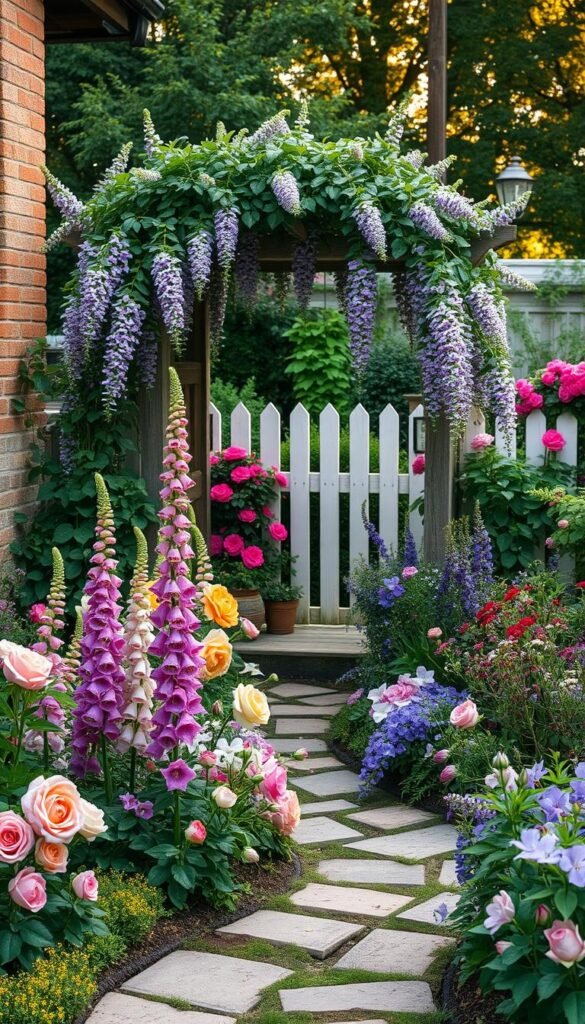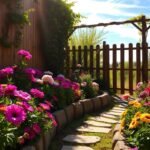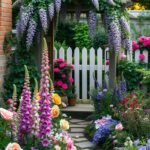Transforming modest outdoor areas into vibrant living spaces requires clever planning and a touch of creativity. Imagine stepping into your personal sanctuary where every plant tells a story and carefully curated elements work together to create harmony. This approach blends abundant greenery with intentional organization, proving even cozy corners can radiate charm.
The magic lies in balancing free-spirited growth with purposeful structure. By layering textures and heights, you craft depth that makes square footage feel expansive. Vertical elements like trellises or hanging planters draw the eye upward, while winding pathways invite exploration – perfect for those seeking ways to maximize your garden’s potential.
Thoughtful arrangements help blur boundaries between indoor and outdoor living. Fragrant blooms near seating areas extend your home’s warmth, while strategic plant placement frames views like living artwork. These techniques maintain that effortless balance between wild beauty and curated spaces that define classic country aesthetics.
You’ll discover how repetition of key plants creates rhythm without monotony, and how seasonal rotations keep displays fresh. With smart plant choices and space-enhancing tricks, your outdoor haven becomes a testament to thoughtful garden design principles – proving grandeur isn’t reserved for sprawling estates.
Embracing the Cottage Garden Charm
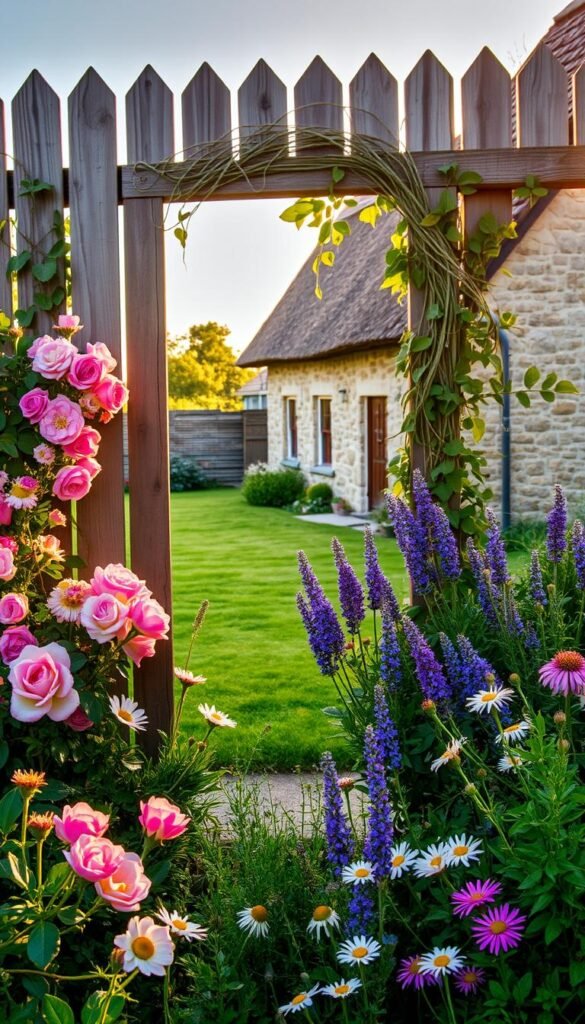
Picture a landscape where flowers spill over weathered stone paths, and fragrant herbs mingle with climbing roses. This effortless blend of nature and design defines the cottage aesthetic, inviting you to slow down and savor every detail. Unlike formal layouts, these spaces celebrate imperfection – think wildflower clusters beside neatly trimmed hedges.
Key Elements of Cottage Garden Design
Start with flowing borders that soften edges and create movement. Mix perennials like lavender with annual blooms for continuous color bursts. Natural materials – think wooden arbors or wrought-iron gates – add rustic character. As one gardener notes, “A weathered bench or vintage watering can becomes part of the story.”
Balancing Order and Abundance
The secret lies in strategic repetition. Plant drifts of your favorite species to establish rhythm, then let self-seeding varieties fill gaps organically. Vertical layers (tall foxgloves, medium peonies, low-growing thyme) maximize visual depth. For more ideas on achieving visual harmony, explore how textures and tones interact.
Embrace asymmetry in your layouts. A curved path here, a birdbath there – these spontaneous touches create that “lived-in” feel. Remember: true cottage style isn’t about perfection, but joyful coexistence between cultivated beauty and nature’s whims.
Small Cottage Garden Ideas: Making the Most of Limited Yard Space
Even the tiniest plots can burst with life through smart design choices and multi-functional plantings. Blend edible herbs with flowering specimens in raised beds – thyme cascading over rosemary bushes, strawberries snuggling beside marigolds. This approach creates functional beauty while conserving ground area.
Vertical layers work wonders in tight quarters. Train beans up obelisks behind dwarf fruit trees, letting morning glories climb nearby fences. As one urban gardener shares, “My hanging baskets hold cherry tomatoes above petunias – snacks and scenery in one spot!”
Containers offer endless flexibility. Try these setups:
| Container Type | Best For | Pro Tip |
|---|---|---|
| Hanging Baskets | Herbs & trailing plants | Use lightweight soil mix |
| Wooden Crates | Leafy vegetables | Line with burlap first |
| Metal Tubs | Statement plants | Drill drainage holes |
Create distinct zones using curved pathways bordered by low hedges. A budget-friendly container filled with basil becomes both a kitchen resource and aromatic divider. Group pots in odd numbers near seating areas – three varying heights of lavender create rhythm without rigidity.
Remember: Every surface holds potential. Wall-mounted planters host succulents where walkways narrow, while window boxes overflow with salad greens. Through layered planting and strategic accents, your plot becomes a tapestry of textures that feels expansive yet intimate.
Creating Inviting Seating Areas and Outdoor Nooks
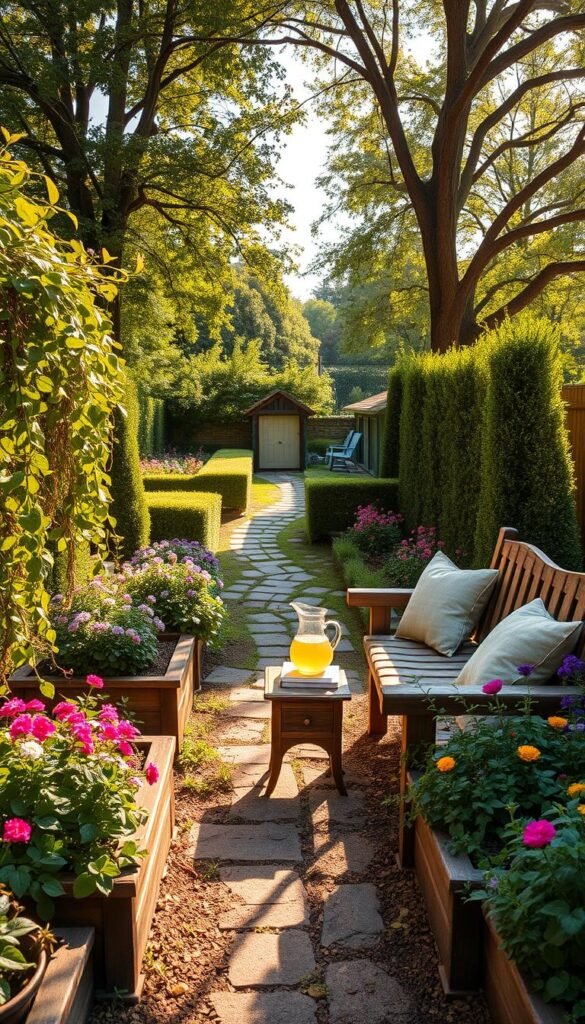
Your outdoor retreat deserves spaces that invite lingering moments and quiet reflection. Thoughtfully designed seating transforms underused corners into destinations, encouraging you to savor morning coffee or evening sunsets. These purposeful arrangements become natural extensions of your home, blending comfort with visual appeal.
Choosing the Perfect Garden Bench
Select furnishings that mirror your landscape’s character. A weathered teak bench nestled under climbing roses whispers rustic charm, while painted ironwork adds vintage flair. “Your seat should feel like part of the scenery,” notes landscape designer Mara Houser. “Let materials age gracefully – lichen-speckled stone or mossy wood tells a story.”
| Bench Style | Best Placement | Maintenance Tip |
|---|---|---|
| Recycled Wood | Under trees | Apply annual sealant |
| Wrought Iron | Path junctions | Check for rust spots |
| Built-In Stone | Flower borders | Pressure wash yearly |
Arranging Cozy Spaces for Relaxation
Cluster chairs where scented blooms catch breezes – lavender near a seating area enhances relaxation. Use low hedges or tall grasses to frame intimate nooks. A bistro set tucked between raised beds creates a breakfast spot surrounded by blossoms.
Position furnishings to highlight favorite views. Angle a swing toward cascading clematis, or place Adirondack chairs where golden hour light filters through birch trees. These intentional sightlines turn ordinary moments into sensory experiences.
Adding Vertical Interest with Arbors, Pergolas, and Trellises
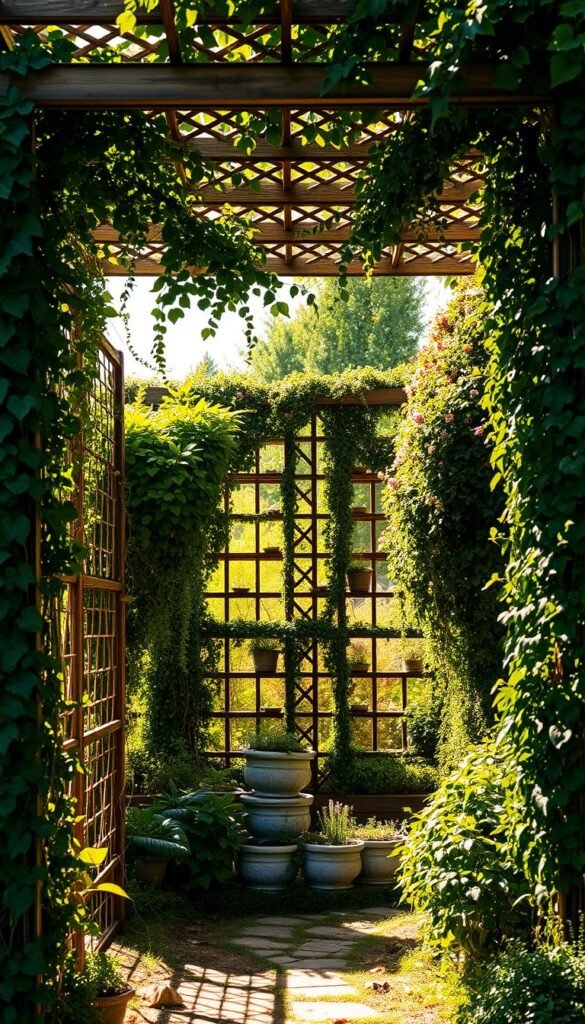
Transform flat layouts into dynamic displays by introducing upward-growing elements. Vertical features add architectural interest while optimizing every inch of your plot. Picture arches dripping with blooms or pergolas wrapped in fragrant vines – these living structures become functional art.
Showcasing Climbing Plants on Arbors
Arbors serve as natural frames for vigorous growers. Train clematis to scramble over wooden arches, pairing early-blooming varieties with late-season stars for continuous color. Passion flowers thrive in sunny spots, their exotic blossoms creating tropical flair. As gardener Elena Cruz advises, “Mix evergreen ivy with flowering vines – you’ll get year-round texture without bare winter bones.”
Utilizing Pergolas for Added Structure
Pergolas define space while supporting lush canopies. Underplant climbing roses with foxgloves for layered beauty – tall spires complement rounded blooms. Consider these combinations:
- Wisteria + lavender (fragrant shaded seating)
- Grapevines + nasturtiums (edible vertical layers)
- Honeysuckle + ferns (woodland retreat vibe)
For budget-friendly vertical solutions, repurpose ladders or pallets as rustic trellises. Group three matching obelisks along a pathway to guide the eye upward. Remember: vertical growth isn’t just about saving ground area – it’s about crafting immersive experiences where every glance reveals new details.
Incorporating Water Features for a Calming Effect
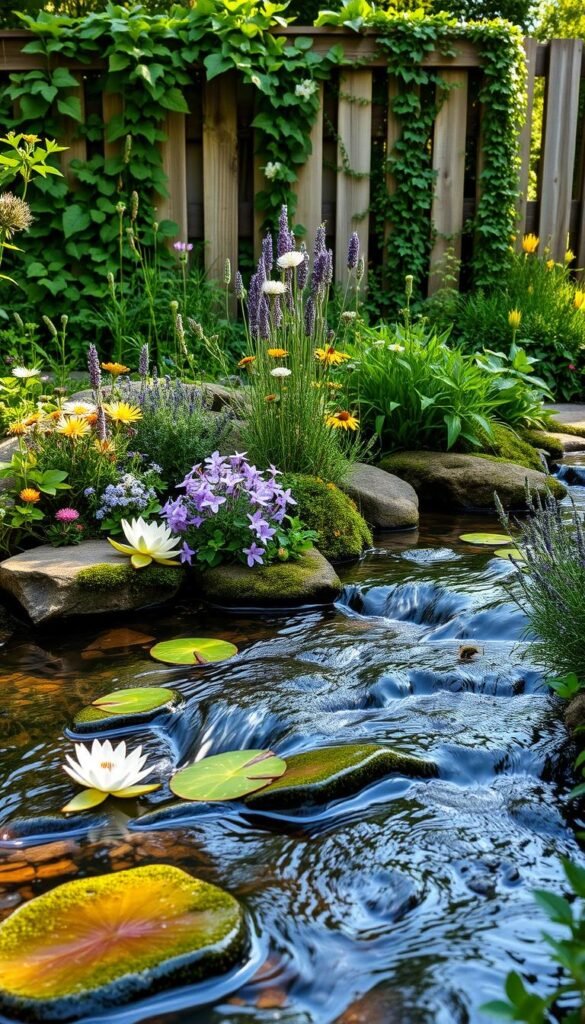
The gentle murmur of moving water transforms outdoor spaces into living ecosystems. A stone birdbath nestled among coneflowers becomes both art and utility, offering feathered visitors drinking spots while enhancing your landscape’s charm. Water elements create natural focal points that engage multiple senses – the sparkle of sunlight on ripples, the soft patter of droplets on leaves.
Fountain and Birdbath Ideas to Attract Wildlife
Choose shallow basins with textured surfaces for safe insect landings. Solar-powered fountains provide motion without wiring, perfect for secluded corners. Position your birdbath near purple coneflowers or black-eyed Susans – their sturdy stems give birds perching spots while hiding the basin’s edge from predators.
| Feature Type | Wildlife Benefits | Maintenance Tips |
|---|---|---|
| Clay Birdbath | Attracts songbirds | Scrub weekly |
| Recirculating Fountain | Supports pollinators | Clean pump monthly |
| Stone Basin | Frog habitat | Refill daily |
During summer’s peak heat, water features cool the air through evaporation. The sound of trickling water masks urban noise, creating an oasis effect. Place your fountain where breezes carry its melody – near seating areas or open windows.
Even modest water sources boost biodiversity. Butterflies sip from damp sand, while bees gather mineral-rich droplets. As landscape designer Tara Nolan observes, “A simple dish with stones becomes a lifeline for tiny creatures.” Pair your water element with nectar-rich blooms to create rest stops for traveling pollinators.
Mixing Annuals and Perennials for Year-Round Color
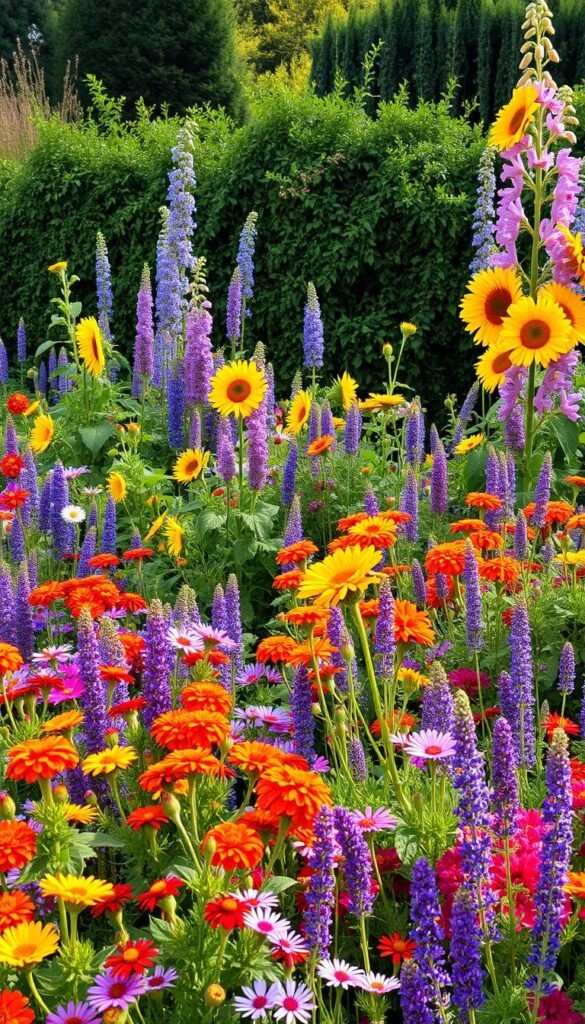
The secret to a vibrant display lies in pairing fleeting beauty with reliable performers. Annuals like zinnias explode with color for one glorious season, while perennials such as coneflowers return like old friends each spring. Together, they weave a tapestry that evolves yet never loses its charm.
Think of perennials as your garden’s backbone – peonies and daylilies establish rhythm through repetition. Annuals become the improvisational artists, filling gaps with spontaneous bursts of cosmos or petunias. A seasoned grower notes, “Marigolds nestle between lavender clumps, hiding bare stems while attracting pollinators.”
Success hinges on matching plant needs. Group sun-loving black-eyed Susans with drought-tolerant California poppies. Shade-dwelling hostas pair beautifully with impatiens in moist soil. This strategic planting ensures all thrive under shared conditions.
| Plant Type | Bloom Duration | Top Picks |
|---|---|---|
| Annuals | 1 Season | Snapdragons, Nasturtiums |
| Perennials | 3+ Years | Salvia, Coreopsis |
Evergreen shrubs like boxwood provide winter structure when flowers fade. For quick summer drama, tuck colorful container arrangements between established perennials. This layered approach creates depth – tall hollyhocks rear behind mid-height daisies, with creeping thyme carpeting edges.
Rotate annuals seasonally: pansies in spring, sunflowers in summer, chrysanthemums in fall. Meanwhile, perennials like asters and sedum ensure autumn fireworks. With thoughtful pairings, your space becomes a living calendar where every month unveils new surprises.
Maximizing Space with Containers and Raised Beds
Elevate your planting game by reimagining how you use upward and outward layers. Containers and raised beds let you craft lush displays while keeping aggressive growers in check – think peppermint’s enthusiastic spread or lemon balm’s wandering roots. This approach puts you in control, turning patios, railings, and overlooked corners into thriving green zones.
Tips for Successful Container Gardening
Start with soil formulated for pots – lightweight mixes prevent compaction while retaining moisture. Fabric grow bags work wonders for tomatoes and peppers, their breathable walls promoting healthy roots. Rotate planters weekly so foliage grows evenly, and cluster herbs like thyme where sunlight lingers longest.
Match pot sizes to your plants’ needs. Deep-rooted veggies thrive in 12-inch containers, while shallow beds suit lettuces and radishes. For thriving edible displays, pair compact cucumbers with nasturtiums – their trailing vines soften edges beautifully. Elevate planters on stands to improve drainage and create visual depth.
Remember: drainage holes are non-negotiable. Add gravel layers beneath soil to prevent waterlogging, and feed plants monthly with organic fertilizer. With these tips, your container garden becomes a dynamic, space-smart oasis that delights season after season.

